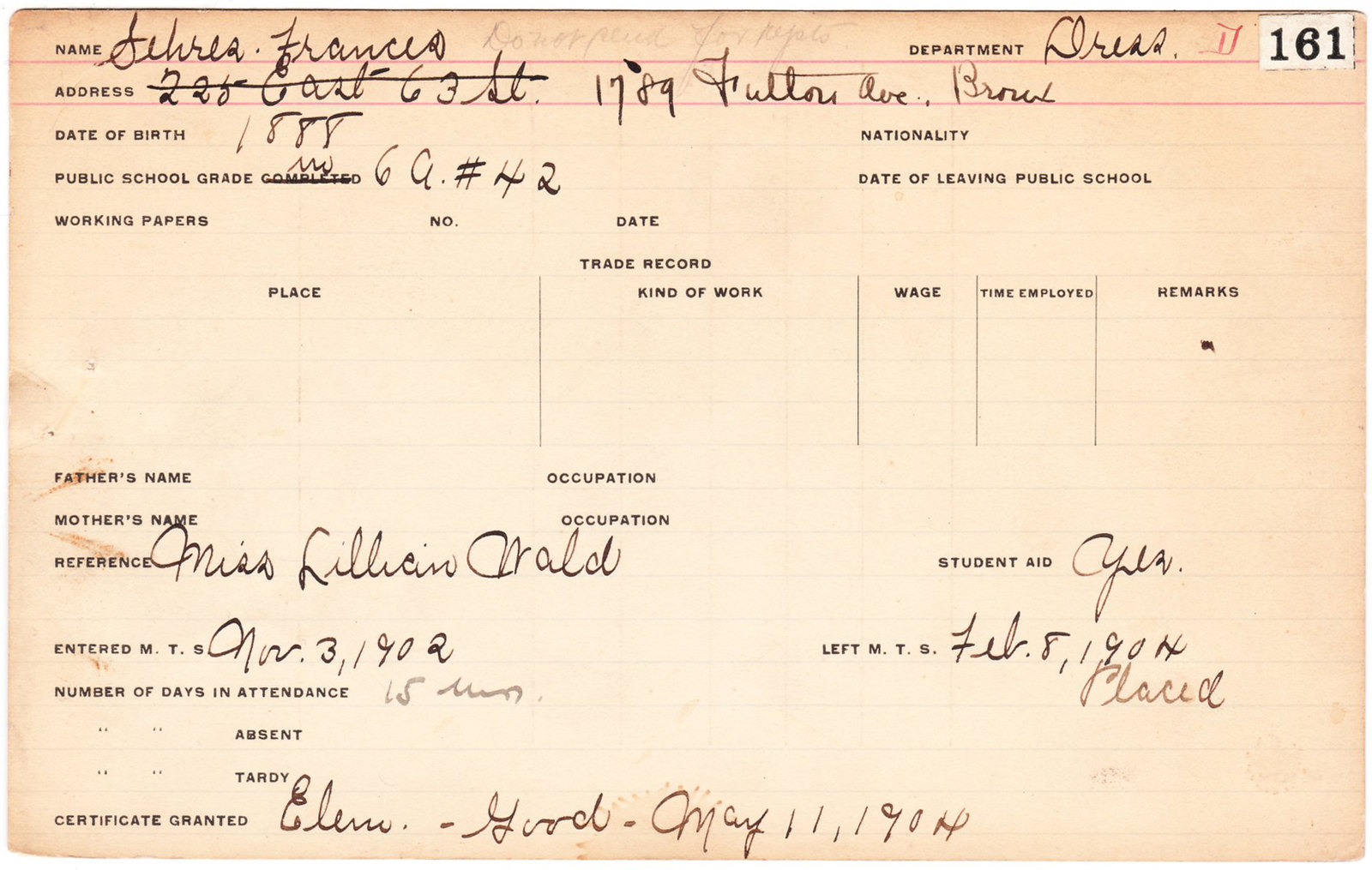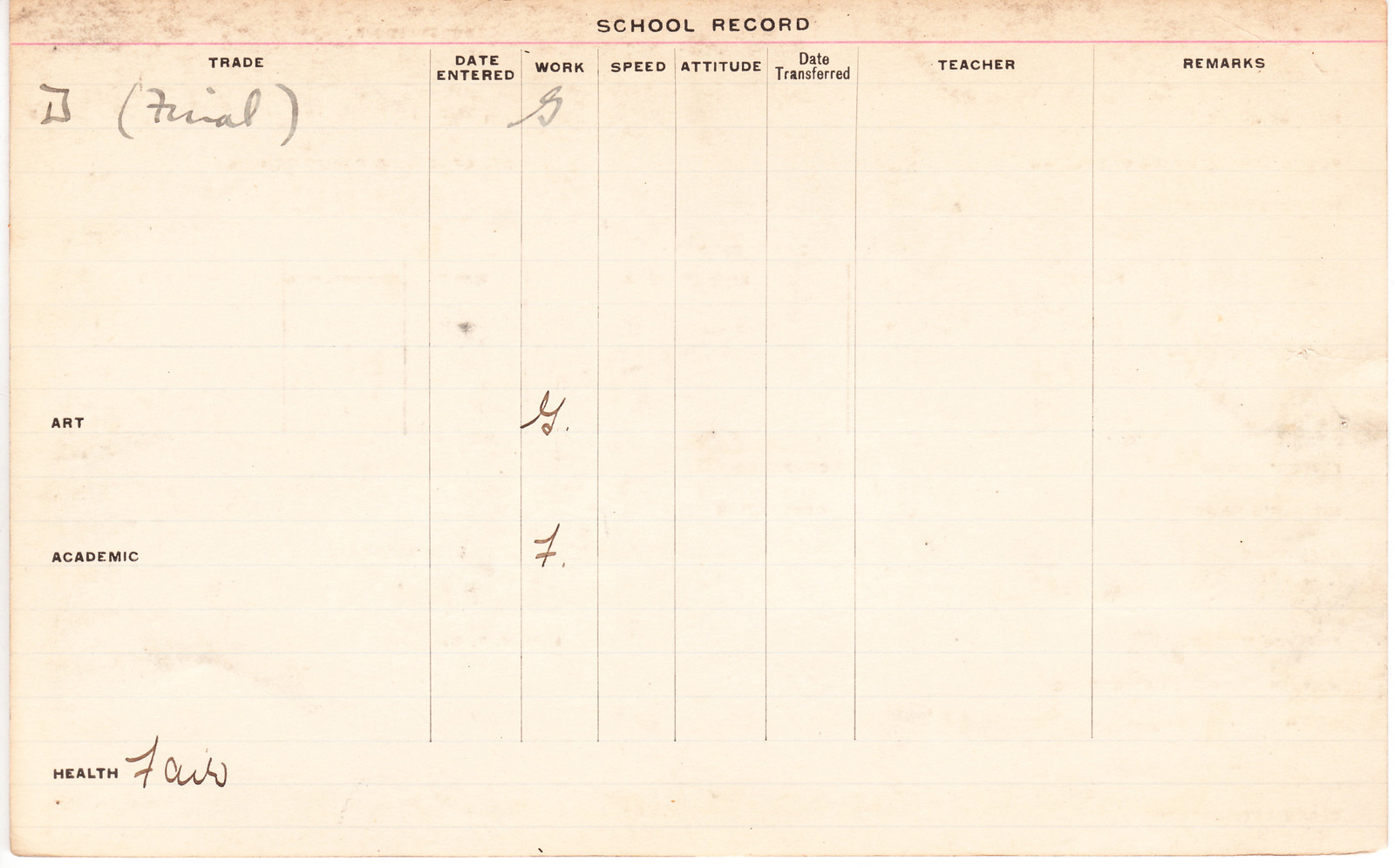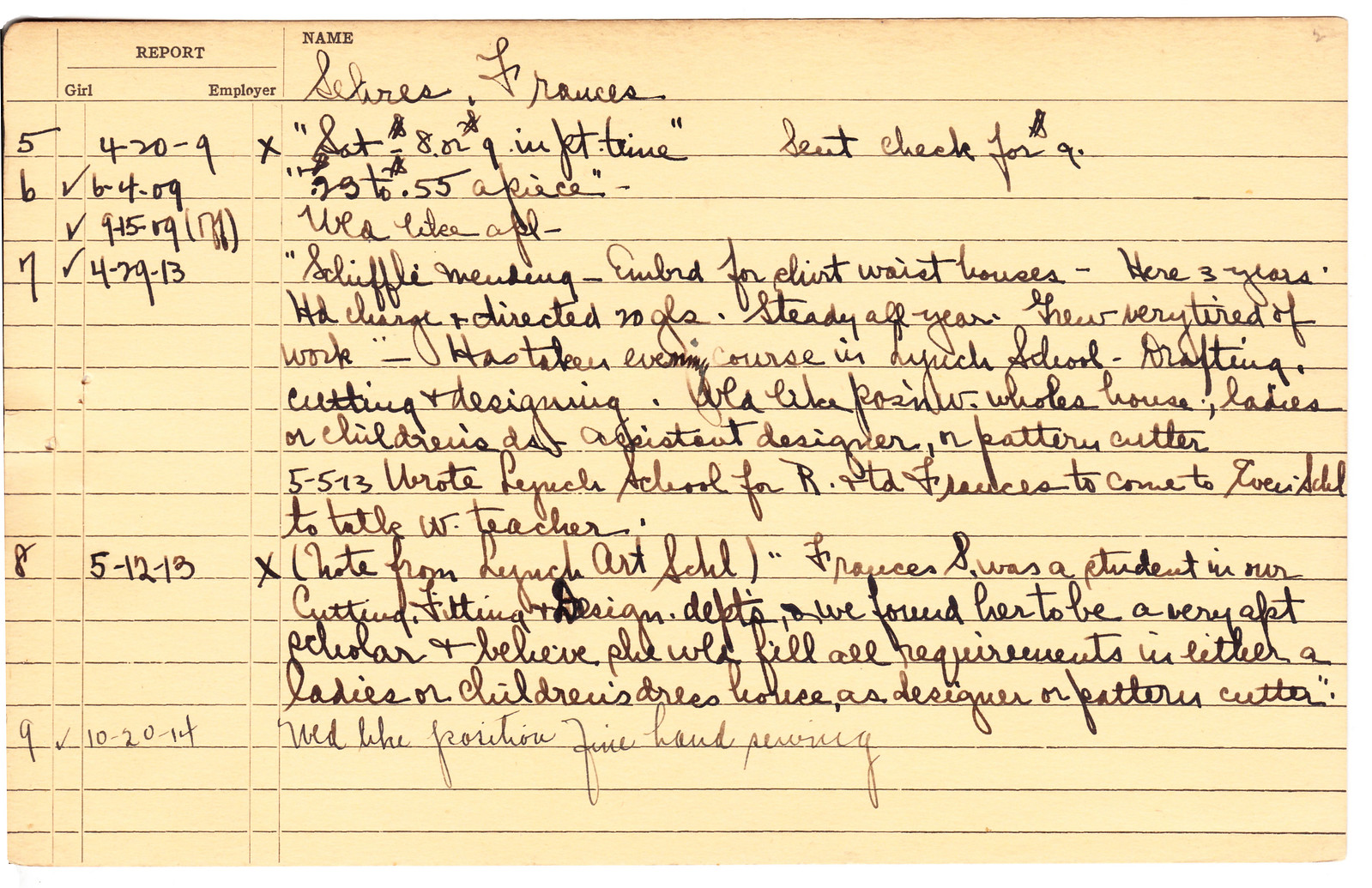
This week we turn our attention to a very special Manhattan Trade School enrollee — Frances Sehres, a dressmaking student whose main card is shown above (with what appears to be a perfect coffee stain splotch preserved at the center of the bottom edge). What's so special about her? This: The Manhattan Trade School for Girls began operations in November of 1902, and Frances's card shows that she was admitted to the school on Nov. 3 of that year, so she was apparently one of the school's very first students.
Interestingly, Frances's birth date is simply listed as "1888." The other Manhattan Trade School cards in my collection show a specific date. But the most intriguing nugget of information on this card is notation that Frances was referred to the school by Miss Lillian Wald. This name meant nothing to me, but longtime PermaRec volunteer researcher Catherine Bloomquist recognized it. It turns out that Wald was a pioneering humanitarian nurse who in 1893 founded the Henry Street Settlement, an important New York City social service agency that still exists today. In the 1940s, the Henry Street Settlement spun off the Visiting Nurse Service, which is also still in operation today.
Wald's original goal was for the Henry Street Settlement to provide services for poor immigrants on Manhattan's Lower East Side. But Frances's card shows that she lived on East 63rd St. and then in the Bronx, both of which are far from Henry Street, so it's not clear to me how Frances's life intersected with Wald. It's possible that the Settlement had expanded its operations throughout the city by 1902, but I'm not sure — a subject for further research.
The school's recordkeeping system was apparently a bit of a work in progress at the beginning. The card that would normally show a bevy of grades and teacher comments was barely touched in Frances's case:

Of greater interest is Frances's employment record, which is spelled out on the next two cards:


Lots of interesting stuff here. For starters, Frances's first job, for the "Singer Co." — presumably the Singer Sewing Machine Company — began on Feb. 8, 1904 (in other words, toward the end of her schooling, which would have been standard procedure at the school). She continued working for Singer on and off through 1905 through 1909, then had a series of non-Singer jobs later in 1909, and finally had a bunch of additional jobs in 1913 and ’14. The final job in her employment record is dated Nov. 11, 1914 — nearly a dozen years to the day after she entered Manhattan Trade. This shows that students were maintaining long-term relationships with the school right from the start — a remarkable phenomenon that's also documented in many of the report cards from the 1910s, ’20s, and ’30s.
In addition, look at the "How Found" column. For many of the jobs, the notation is "MTS" (i.e., Manhattan Trade School, meaning the school arranged the job for Frances), but many others have "Self." This means Frances obtained many of these jobs on her own but nonetheless kept the school apprised of her employment activities — another indication of the close bond between the school and its students, right from the start.
And how were Frances's work experiences? Surprisingly, there's no feedback — either from Frances or from her employers — until one of her 1909 gigs. It's possible that the school hadn't yet adopted its eventual system of recording this type of feedback in its early years. Anyway, here are the cards with the employment related commentary:

That first entry, which refers to one of Frances's stints at Singer in 1909, indicates that a supervisor was not thrilled with her, and also includes a doozy of a dated put-down (as usual, I've spelled out some abbreviated terms for clarity):
Miss ______, head of the Sample Department, said, "Franny was never very satisfactory. Was not interested in her work. Never tried to advance — unambitious and was insubordinate (insisted on using the front elevator!) and impertinent in manner. Was not dismissed, but we were glad to have her go and never could return."
Imagine — a mere laborer using the front elevator! It's interesting that Singer kept Frances on for so many years despite this apparent dissatisfaction with her. Sounds like sour grapes after she left, no?
As for the assessment of Frances being "unambitious," that's demonstrably false, as shown in a series of entries on this card:

The pertinent passages are as follows:
April 29, 1913: Has taken evening course in Lynch School — drafting, cutting and designing. Would like position with a wholesale house, ladies' or children's [clothing], as an assistant designer or pattern cutter.May 5, 1913: Wrote [to] Lynch School for reference and told Frances to come to [illegible] School to talk with teacher.
May 12, 1913: Note from Lynch Art School: "Frances S. was a student in our Cutting, Fitting, and Design departments and we found her to be a very apt scholar and believe she would fill all requirements in either a ladies' or children's dress house, as a designer or pattern cutter."
That's all I have for Frances. If anyone knows more about what happened to her, please get in touch. Thanks.
(Special thanks to Catherine Bloomquist for recognizing the importance of Lillian Wald's name in Frances's file.)
Update: Last week's entry on Fannie Panio prompted PermaRec reader Joe Lombardo to do a bit of research. He found Fannie in the 1940 census, where was listed as being married to a man named John Verdigi. Their household included two children; Fannie's mother, Catherine (this name matches the name listed on Fannie's report card), and another relative from Fannie's side of the family.
Joe also found a death notice indicating that Fannie died in 1997 (she would have been 87) and that she and John had one additional child after 1940. Interestingly, the death notice lists Fannie as "Philomena" and John as "Giovanni," but birth date matches Fannie's report card and the first two children's names match the ones on the 1940 census entry, so I'm fairly certain that this is indeed our Fannie.
Good work, Joe — thank you!

No comments:
Post a Comment